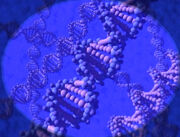
DNA, the genetic programming of a lifeform
A lifeform, while not having an exact definition, is generally an entity which is able to act in its self interest or self preservation through some level of comprehension. The study of lifeforms is known as biology, and, when dealing with alien lifeforms, could be further sub-categorized into xenobiology and xenology.
Criteria for determining whether something was a lifeform ranged from the ability to assimilate to its surroundings, respirate, reproduce, grow and develop, move, secrete, and excrete. Regardless, these criteria rarely defined the physical makeup of a lifeform, as organic, inorganic, and artificial entities have been considered lifeforms. (TNG: "Datalore"; TNG: "Home Soil"; TNG: "Elementary, Dear Data"; TNG: "The Measure Of A Man")
Most space-faring civilizations built devices to remotely detect and locate known lifeforms. Starship sensors and tricorders were the primary instruments used, as they could identify or localize blood type, heart rate or metabolic setup. Typically, only organic lifeforms were detected. (TNG: "Home Soil")
Starfleet lifeform classes and types
- Classification R-3 lifeforms (Sheliak)
- Class-5 lifeforms (Vhnori)
- Order 480-G anthropoids (Taurus II natives)
Kingdoms
Other types of life
- Artificial
- Biomimetic lifeform
- Carbon-based
- Cybernetic
- Silicon-based
- Solanogen-based
- Spaceborne
- Viral
- Xenon-based
- Sporocystian
See also
- Anatomy
- Non-sentient lifeforms
- Species and cultures
